![]()
![]()
![]()
Use LEFT and RIGHT arrow keys to navigate between flashcards;
Use UP and DOWN arrow keys to flip the card;
H to show hint;
A reads text to speech;
24 Cards in this Set
- Front
- Back
|
Four basic taste qualities and their associated components
|
Salty - sodium chloride
Sour - Hydrogen ions Sweet - sugars Bitter - toxic or poisonous substances |
|
|
Components of a Taste bud
|
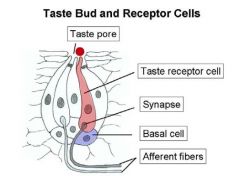
Taste receptor and Basal cell
|
|
|
Taste receptor cells:
• lack this normal component of neurons • its two poles - direction they are oriented - site of fxn |
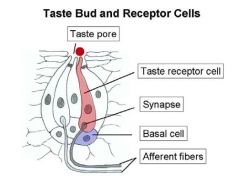
Taste receptor cells:
• lack axons • Apical pole - Oriented towards the taste pore - site of signal transduction • Basal pole - Oriented towards the basal lamina - site of transmitter release, which activate afferent fibers that eventually form different cranial nerves |
|
|
Basal cells:
• Location • main fxn |
Basal cells:
• Located at the base of taste buds • Form the precursors for the development of new taste receptor cells |
|
|
Signal Transduction Mechanism for Salty and Sour:
- Type of channel receptor used - ion currents involved in depolarization |
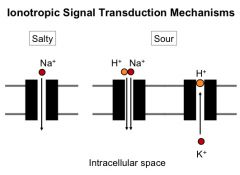
Signal Transduction Mechanism for Salty and Sour:
• Both use ionotropic receptors • Salty - Depolarization involves > Na+ flowing into the receptor cell > v-gated Ca2+ channels opening > Transmitter release from synaptic vesicles at the base of the receptor cell • Sour - Depolarization involves > H+ & Na+ flow into the receptor cell > Also H+ blocks K+ channels, preventing K+ from leaving the cell > v-gated Ca2+ channels opening > Transmitter release from synaptic vesicles at the base of the receptor cell |
|
|
Signal Transduction Mechanism for Sweet:
- Type of channel receptor used - ion currents involved in depolarization - Describe the general pathway starting with a gustatory molecule |
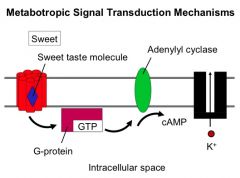
Signal Transduction Mechanism for Sweet:
• Uses metabotropic receptors with the following scheme that block K+ from leaving the cell - A taste molecule binds to a G-protein, activating its Gs subunit with GTP - Gs-ATP activates Adenylyl cyclase which convert ATP to cAMP, the 2nd messenger - cAMP causes the closure of K+ channels, reducing the outward positive current ---> depolarization - v-gated Ca2+ channels open whose inward current causes depolarization |
|
|
Signal Transduction Mechanism for Bitter:
- Type of channel receptor used - ion currents involved in depolarization - Describe the general pathway starting with a gustatory molecule |
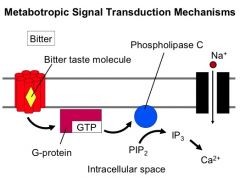
Signal Transduction Mechanism for Bitter:
• Uses metabotropic receptors with the following scheme that lead to Na+ entering the cell - A taste molecule binds to a G-protein, activating its Gq subunit with GTP - Gq-ATP activates Phospholipase C which converts PIP2 to DAG and IP3 - IP3 increases intracellular [Ca2+] - DAG opens the Na+ channels, increasing the inward positive current ---> depolarization - the increase in [Ca2+] leads to transmitter release fro the basal pole of receptor cells, activating afferent fibers *** It should be noted that the bitter taste ALSO uses the same scheme for sour taste where K+ channels are blocked but with metabotropic receptors |
|
|
Gustatory Pathway;
• How it differs from other sensory pathways • The CNs involved (3), what they iNN, and the type of info they carry • The primary afferent neurons - have this type of morphology - the location of their cell bodies - where they originate and travel - their synaptic target • 2nd order neurons - trajectory and their synaptic target • 3rd order neurons - their location - their synaptic target and the relative location of this target |
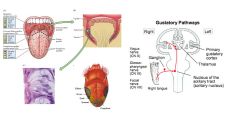
Gustatory Pathway;
• The pathway does not cross the body's midline, it stays ipsilateral • The CNs involved (3) and their iNNs - CN VII: iNN anterior 2/3 of the tongue, carry sensory info for sweet; salty and sour - CN IX: iNN posterior 1/3; carry sensory info for sour and bitter - CN X: iNN further back of tongue; n/a • The primary afferent neurons - pseudounipolar morphology - the location of their cell bodies are in the following ganglia > Geniculate ganglion of CN VII, Facial nerve > Inferior ganglion of the CN IX, Glossopharyngeal nerve > Inferior ganglion of the CN X, Vagus nerve - originate in the tongue and enter the brainstem at the pontomedullary jxn - synapse at the solitary nucleus • 2nd order neurons - ascend ipsilaterally and synapse in the Ventral Posterior Medial nucleus • 3rd order neurons - located in the thalamus - synapse in the primary gustatory cortex, located in the insular lobe and lower parts of the post-central gyrus |
|
|
Signal Transduction Mechanism for the Olfactory System:
• Type of receptor channel used • Describe the general pathway, starting with an odorant molecule • The type of potentials formed as a result of depolarization |

Signal Transduction Mechanism for the Olfactory System:
• Metabotropic • The general pathway - An odorant molecule in the olfactory mucosa activates an odorant receptor - A G-protein is activated with Gs-GTP dissociating and activating adenylyl cyclase - Adenyly cyclase converts ATP to cAMP - cAMP binds to a cation channel and Ca2+ & Na+ flow into the receptor cell • Graded receptor potentials are formed |
|
|
Briefly explain how 10's of thousands of odorant molecules can be discriminated by a system with only ~1000 different odorant receptors
What sort of potentials are generated |
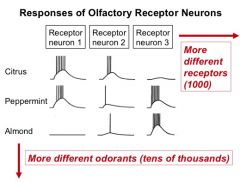
A single odorant molecule stimulates more than one type of odorant receptor but the stimulation is to different degrees. An odorant has a pattern of depolarization.
Graded potentials are generated |
|
|
The relationship btwn the glomerulus of the olfactory bulb and olfactory receptor neurons
|

The glomerulus is where the olfactory neurons synapse. The glomerulus receives input from only one type of olfactory neuron.
|
|
|
Briefly explain the "vertical" and "horizontal" flow of info in tthe olfactory bulb
|

Vertical flow: Starts with the olfactory receptors synapsing at the glomeruli of the olfactory bulb
Horizontal flow: consists of inhibitory neurons which lie btwn adjacent glomeruli within the bulb Th inhibitory neurons will help discriminate odors as they will alter the excitation of different types of receptor neurons |
|
|
Before the output neurons of the olfactory bulb reach the thalamus, they first synapse here
|
They synapse at the olfactory cortex
|
|
|
Some characteristics of the olfactory pathway:
• How it differs from other sensory pathways • is in close relation to this system • Three components of the olfactory cortex, the lobe in which the are located, and a structure that is close by |

• The olfactory pathway reaches the primary sensory cortex directly, without thalamo-cortical projections
• Close relation to the limbic system • Piriform cortex peri-amygdaloid cortex and entorhinal cortex located in the temporal lobe around the region of the Uncus |
|
|
Before the output neurons of the olfactory bulb reach the thalamus, they first synapse here
|
They synapse at the olfactory cortex
|
|
|
Some characteristics of the olfactory pathway:
• How it differs from other sensory pathways • is in close relation to this system • Three components of the olfactory cortex, the lobe in which the are located, and a structure that is close by |
• The olfactory pathway reaches the primary sensory cortex directly, without thalamo-cortical projections
• Close relation to the limbic system • Piriform cortex peri-amygdaloid cortex and entorhinal cortex located in the temporal lobe around the region of the Uncus |
|
|
The Vomeronasal Organ:
• another term • morphology of its receptor neurons • its main fxn |
The Vomeronasal Organ:
• Jacobson's organ • bipolar • Fxns as a chemoreceptor organ that is important in pheromone communication |
|
|
Before the output neurons of the olfactory bulb reach the thalamus, they first synapse here
|
They synapse at the olfactory cortex
|
|
|
Some characteristics of the olfactory pathway:
• How it differs from other sensory pathways • is in close relation to this system • Three components of the olfactory cortex, the lobe in which the are located, and a structure that is close by |
• The olfactory pathway reaches the primary sensory cortex directly, without thalamo-cortical projections
• Close relation to the limbic system • Piriform cortex peri-amygdaloid cortex and entorhinal cortex located in the temporal lobe around the region of the Uncus |
|
|
The Vomeronasal Organ:
• another term • morphology of its receptor neurons • its main fxn |
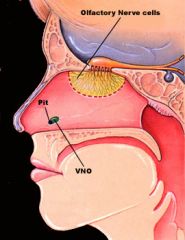
The Vomeronasal Organ:
• Jacobson's organ • bipolar • Fxns as a chemoreceptor organ that is important in pheromone communication |
|
|
Ageusea
• Def • Etiology • often occurs in this orientation |
Ageusea
• Loss of taste fxn • Etiology - lesion of the chorda tympani of CN VII - Wallenberg's syndrome/PICA Syndrome • often occurs unilaterally, ipsilateral loss of taste on the anterior 2/3 of the tongue |
|
|
Hyposmia
• Def • Clinical manifestation |
Hyposmia
• Decreased smell fxn • Complaint of being unable to taste |
|
|
Anosmia
• Def • Etiology |
Anosmia
• Complete loss of smell • Compression of the olfactory tract by tumors, i.e. meningeomas |
|
|
Olfactory Hallucinations
• Type of episode onset and location of the episode |
Olfactory Hallucinations
• Partial epileptic seizure, originating in the vicinity of the uncus |

